Heavy metals are one of the major pollutants that contribute to the escalating problem of environmental pollution, being primarily introduced in sensitive ecological habitats through industrial effluents, wastewater, as well as sewage of various industries. Microbial bioremediation, particularly the use of bacteria, has gained attention due to the feasibility and efficiency of using them in removing heavy metals from contaminated environments. Bacteria have several methods of processing heavy metals through general resistance mechanisms, biosorption, adsorption, and efflux mechanisms. Bacillus spp. are model Gram-positive bacteria that have been studied extensively for their biosorption abilities and molecular mechanisms that enable their survival as well as their ability to remove and detoxify heavy metals.
- bioremediation
- Bacillus
- resistance
- microorganisms
- biosorption
- efflux
- heavy metals
1. Bioremediation—An Environmentally-Friendly Approach for the Removal of Heavy Metals
2. Bacillus Species and Heavy Metals
2.1. Arsenic
Bioregulation of Arsenic by Bacillus spp.
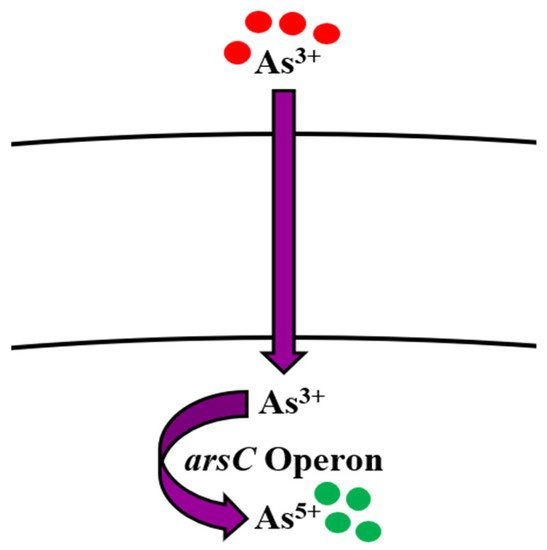
| Metal | Bacterial Strains | Initial Metal Concentration (%/mg/g/mM/ppm/mg/L) |
Metal Uptake Ability (%/mg/g/mM/ppm/mg/L/mol/g) |
Reference |
|---|---|---|---|---|
| Arsenic | Bacillus sp. KM02 | 100 ppm | 51.45% (As3+) | [59] |
| B. licheniformis B. polimyxa |
0–100 mM 0–20 mM |
100 ppm (As0) 100 ppm (As0) |
[88] | |
| Bacillus sp. IIIJ3–1 | 350 smM (As5+) 10 mM (As3+) |
350 mM (As5+) 10 mM (As3+) |
[71] | |
| B. barbaricus | - | 20 mM (As5+) 0.3 mM (As3+) |
[91] | |
| B. indicus Sd/3T | 0 mM 0 mM |
20 mM (As5+) 30 mM (As3+) |
[89] | |
| B. selenatiredreducens | 10 mM | 0 mM (As5+) 0.3 mM (As3+) |
[87] | |
| B. arsenicus con a/3 | 20 mM 0.5 mM |
20 mM (As5+) 0.3 mM (As3+) |
[90] | |
| B. cereus W2 | 50 mg/L | 1.870 mg/L (As3+) | [86] | |
| B. cereus EA5 B. fusiformis EA2 |
15 mg/L | 94.9% 99.7% |
[84] | |
| B. arsenicus MTCC 4380 | 2000 mg/L 1800 mg/L |
89.462% (As5+) 83.043% (As3+) |
[92] | |
| Zinc | B. subtilis | 178 mg/L | 49.7 mg/L | [105] |
| Bacillus sp. (KF710041) B. subtilis (KF710042) |
- | 73.29% 78.15% |
[106] | |
| B. licheniformis | - | 53% | [107] | |
| B. cereus | 0–200 mg/L | 66.6 mg/g | [108] | |
| B. jeotgali | 75 mg/l | 30% | [109] | |
| B. subtilis D215 | 100 mg/L | 63.73% | [110] | |
| B. firmus | 100 mg/L | 61.8% | [111] | |
| B. altitudinis | 100 mg/L | 87 mg/L | [112] | |
| Nickel | B. subtilis | 2.14 ppm | 85.61% | [113] |
| B. subtilis BM1 B. subtilis BM2 B. subtilis BM3 |
2–32 mg/L | 98.54% 99.2% 96.3% |
[114] | |
| B. subtilis | 178 mg/L | 57.8 mg/g | [105] | |
| Bacillus sp. KL1 | 100 ppm | 55.06% | [115] | |
| B. thuringiensis KUNi1 | 0–7.5 mM | 82% | [116] | |
| B. thuringiensis OSM29 | 25–150 mg/L | 94% | [117] | |
| B. thuringiensis | 250 mg/L | 15.7% | [118] | |
| Cadmium | B. safensis | 40 ppm 60 ppm |
83.5% 98.10% |
[119] |
| B. licheniformis | - | 98.34% | [120] | |
| B. catenulatus JB-022 | 150 mg/L | 66% | [121] | |
| B. thuringiensis DM55 | 0.25 mM | 79% | [122] | |
| Lead | B. pumilus MF472596 | 100–1000 ppm | 96% | [123] |
| B. subtilis X3 | 200–1400 mg/L | 590.49 mg/g | [124] | |
| B. cereus | 5–100 mg/L | 36.71 mg/g | [125] | |
| Bacillus S1 Bacillus SS19 |
75 and 100 mg/L 50 mg/mL |
53%, 51% 57% |
[126] | |
| Bacillus sp. AS2 | 500 ppm | 74.5 mg/g (99.5 %) | [127] | |
| Copper | B. cereus | 100 ppm | 54% | [128] |
| B. cereus | 400 ppm | 48% | [129] | |
| B. thuringiensis OSM29 | 25 mg/L | 91.8% | [117] | |
| B. licheniformis | 5 gm/L | 32% | [130] | |
| B. thioparans | 40 mg/L | 27.3 mg/g | [131] | |
| B. subtilis D215 | 100 mg/L | 67.18% | [110] | |
| B. sphaericus B. cereus Bacillus sp. |
17.6 mg/L 44.0 mg/L 88.0 mg/L |
5.6 mol/g 5.9 mol/g 6.4 mol/g |
[132] | |
| Bacillus sp. SG-1 | - | 60% | [133] | |
| Chromium | B. cereus NWUAB01 | 100 mg/L | 43% | [134] |
| B. cereus | 100 mg/L | 81% | [135] | |
| B. salmalaya 139SI | 50 ppm | 20.35 mg/g | [136] | |
| B. cereus FA-3 | 1000 μg/ml | 72% | [137] | |
| B. licheniformis | 15 mg/L | 95% | [138] | |
| Bacillus sp. B | 500–4500 mg/L | 47% | [139] | |
| B. marisflavi | 200 mg/L | 5.783% | [140] | |
| B. licheniformis | 300 mg/g | 69.4% | [141] | |
| B. thuringiensis | 250 mg/L | 83.3% | [142] | |
| B. licheniformis B. laterosporus |
- | 62 mg/g 72.6 mg/g |
[143] | |
| B. circulans B. megaterium |
0.96 mg/L | 34.5% 32% |
[144] | |
| Mercury | B. thuringiensis CASKS3 | 200 mg/L 400 mg/L 600 mg/L |
62.4% 54% 40% |
[145] |
| B. licheniformis | 50 mg/L | 70% | [146] | |
| B. cereus BW-03(pPW-05) | 5–50 ppm | 96.4% | [147] | |
| B. licheniformis | 100 μg/mL | 70% | [148] | |
| B. cereus | 5 mg/L | 104.1 mg/g | [149] | |
| Bacillus sp. | 1–10 mg/L | 7.9 mg/g | [150] | |
| Manganese | B. thuringiensis HM7 | 400 mg/L | 95.04% | [151] |
| B. cereus HM-5 | 600 mg/L | 67% | [152] | |
| Bacillus sp. | 13.3 mg/g | 55.56 mg/g | [153] | |
| Molybdenum | Bacillus sp. Zeid 14 | - | 200 mg/L | [154] |
| Bacillus sp. strain A.rzi | 0.1 mM | Not reported | [155] | |
| Silver | B. licheniformis R08 | 100 mg/L | 73.6 mg/g | [156] |
| Metal | Protein(s)/Gene(s) | Method(s) | Reference |
|---|---|---|---|
| Arsenic | ars operon (arsR, arsD, arsA, arsB, arsC) | Reduction (Detoxification) Efflux Cell membrane binding, Adsorption on cell surface Complexation by exopolysaccharides |
[59,81,87,99,100,101,102] |
| Zinc | Zur ZosA ycdHI-yceA yciABC CadA CzcD |
Physico-chemical adsorption Ion exchange Efflux Uptake |
[108,157,158] |
| Nickel | CzcD CitM |
Efflux | [159,160] |
| Cadmium | cad operon yvgW KinA |
Efflux | [122,134,161,162,163,164,165] |
| Lead | pbr operon | Efflux | [166,167,168] |
| Copper | CueR copZA operon (CopA, CopZ, CopB) YcnJ |
Efflux by chaperone Uptake |
[169,170,171,172] |
| Chromium | ChrR | Efflux, Uptake Enzymatic reduction (Detoxification) |
[173,174,175] |
| Mercury | mer operon (merR, merA, merB) MerR MerA MerB |
Efflux Enzymatic reduction (Detoxification) |
[176,177,178,179,180] |
| Manganese | mntABCD operon MntR MntH MneP MneS |
Efflux Uptake |
[181,182,183,184] |
| Molybdenum | modABC operon | Uptake | [148,185,186,187,188,189,190] |
| Gold | Not reported | Bioaccumulation | [191,192] |
| Silver | SilP sil genes |
Efflux | [193,194,195,196,197,198] |
2.2. Zinc
Bioregulation of Zinc by Bacillus spp.
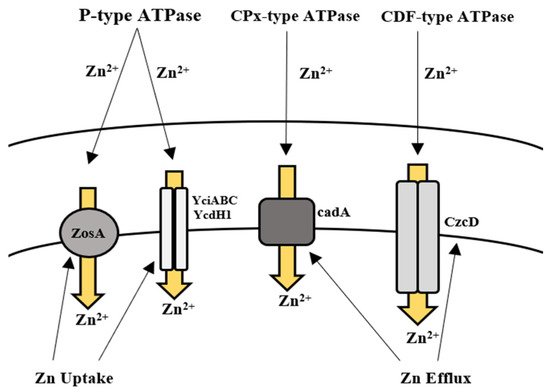
2.3. Nickel
Bioregulation of Nickel by Bacillus spp.
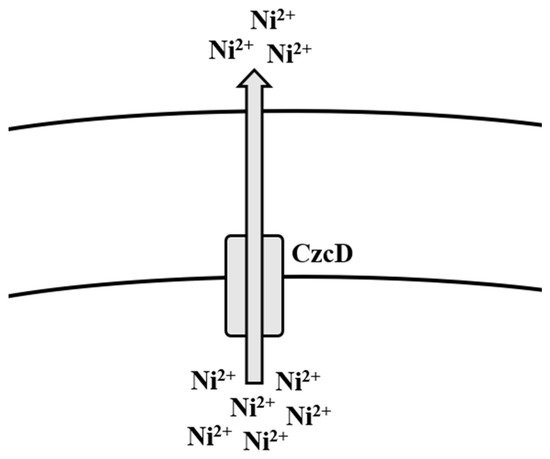
2.4. Cadmium
Bioregulation of Cadmium by Bacillus spp.
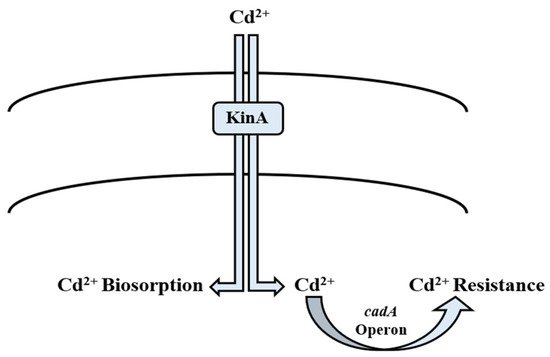
2.5. Lead
Bioregulation of Lead by Bacillus spp.
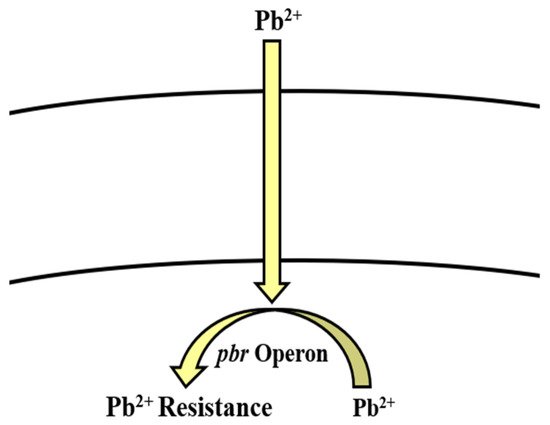
2.6. Copper
Bioregulation of Copper by Bacillus spp.
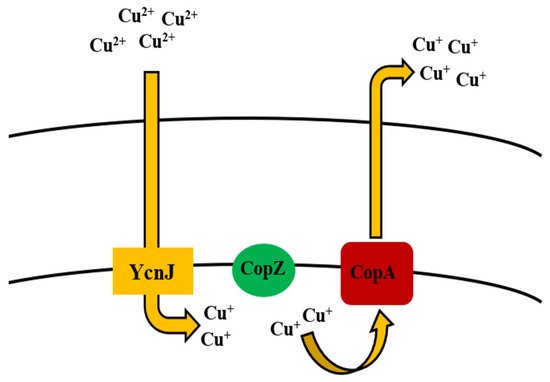
This entry is adapted from the peer-reviewed paper 10.3390/microorganisms9081628
